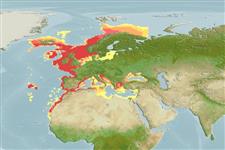Environment: milieu / climate zone / djupintervall / distribution range
Ekologi
marina bottenlevande; djupintervall 18 - 1075 m (Ref. 58452), usually 70 - 400 m (Ref. 35388). Temperate; 76°N - 18°N, 30°W - 42°E (Ref. 58452)
Eastern Atlantic: Norway and Iceland, southward to Mauritania. Also in the Mediterranean Sea and along the southern coast of the Black Sea.
Length at first maturity / Size / Vikt / Age
Könsmognad: Lm 42.1, range 20 - 70 cm
Max length : 140 cm TL hane/ej könsbestämd; (Ref. 1371); common length : 45.0 cm TL hane/ej könsbestämd; (Ref. 1371); publicerad maxvikt: 15.0 kg (Ref. 1371); rapporterad maxålder: 20 år (Ref. 35388)
Taggstrålar i ryggfenan (totalt) : 0; Mjukstrålar i ryggfenan (totalt) : 43 - 51; Mjukstrålar i analfenan: 36 - 40. Inside of mouth and branchial cavity black. Second dorsal and anal fins notched. First vertebra and neural spine attached to skull. Vertebrae 50-52.
Body shape (shape guide): elongated.
Minimum depth from Ref. 128002. Found usually between 70 and 370 m depth. Adults live close to the bottom during day-time, but move off-bottom at night. Adults feed mainly on fish (small hakes, anchovies, pilchard, herrings, cod fishes, sardines and gadoid species) and squids. The young feed on crustaceans (especially euphausiids and amphipods). Are batch spawners (Ref. 51846). Almost entirely marketed fresh, whole or filleted, to specialized restaurants or retail markets (Ref. 58452). Utilized fresh, dried or salted and frozen; can be steamed, fried, microwaved and baked (Ref. 9988). Stocks seem to be over-fished (Ref. 35388).
Continuous recruitment of oocytes connotes indeterminate fecundity for this species (Ref. 79799).
Cohen, D.M., T. Inada, T. Iwamoto and N. Scialabba, 1990. FAO species catalogue. Vol. 10. Gadiform fishes of the world (Order Gadiformes). An annotated and illustrated catalogue of cods, hakes, grenadiers and other gadiform fishes known to date. FAO Fish. Synop. 125(10). Rome: FAO. 442 p. (Ref. 1371)
IUCN Red List Status (Ref. 130435: Version 2025-1)
Threat to humans
Harmless
Human uses
Fiskeri: kommersiellt viktig; sportfisk: ja
Verktyg
Special reports
Download XML
Internet-källor
Estimates based on models
Preferred temperature (Ref.
123201): 6.9 - 15.4, mean 10.2 °C (based on 672 cells).
Phylogenetic diversity index (Ref.
82804): PD
50 = 0.5000 [Uniqueness, from 0.5 = low to 2.0 = high].
Bayesian length-weight: a=0.00468 (0.00421 - 0.00519), b=3.12 (3.09 - 3.15), in cm total length, based on LWR estimates for this species (Ref.
93245).
Trofisk nivå (Ref.
69278): 4.4 ±0.0 se; based on diet studies.
Generation time: 9.2 (8.5 - 10.4) years. Estimated as median ln(3)/K based on 92
growth studies.
Resiliens (Ref.
120179): Mellan, lägsta populationsfördubblingstid 1,4-4,4 år (K=0.1; tm=3, tmax=20; Fecundity=7 million).
Prior r = 0.48, 95% CL = 0.32 - 0.72, Based on 34 full stock assessments.
Fishing Vulnerability (Ref.
59153): High vulnerability (65 of 100).
🛈
Climate Vulnerability (Ref.
125649): Moderate vulnerability (39 of 100).
🛈
Nutrients (Ref.
124155): Calcium = 8.42 [4.50, 24.86] mg/100g; Iron = 0.22 [0.08, 0.52] mg/100g; Protein = 17.7 [16.7, 18.7] %; Omega3 = 0.248 [0.172, 0.355] g/100g; Selenium = 34.6 [19.1, 64.2] μg/100g; VitaminA = 11.8 [3.4, 39.2] μg/100g; Zinc = 0.246 [0.175, 0.341] mg/100g (wet weight); based on
nutrient studies.
